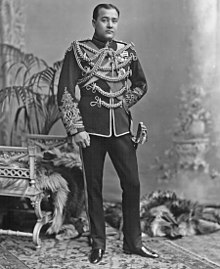Nripendra Narayan
GCSI | |
|---|---|
 Nripendra Narayan Bhup Bahadur, Maharaja of Cooch Behar, in the year 1902 in the dismounted review order uniform of a British officer of the 6th (Prince of Wales's) Bengal Cavalry | |
| Born | 4 October 1862 |
| Died | 18 September 1911 (aged 48) |
| Alma mater |
|
| 21st Maharaja of Cooch-Behar | |
| Reign | 6 August 1862 – 18 September 1911 (Ruled as Maharaja from 16 October 1884 — 18 September 1911) |
| Predecessor | Narendra Narayan |
| Successor | Rajendra Narayan II |
| Spouse | |
| Issue |
|
| Dynasty | Koch |
| Father | Narendra Narayan |
Maharaja Nripendra Narayan (4 October 1862 – 18 September 1911) was the Maharaja of the princely state of Cooch Bihar, India, from 1863 to 1911.[1][2]
Early life
Nripendra Narayan was only ten months old when his father,

Family
He was the father of four sons and three daughters: sons Rajendra Narayan (b.1882), Jitendra Narayan (b.1886), Victor Nityendra Narayan (b.1888), and Hitendra Narayan (b.1890), and daughters Sukriti Devi (b.1884), Pratibha Devi (b.1891), Sudhira Devi (b.1894).[5][6]
Of his sons, Rajendra and Jitendra later became Maharajas of Cooch Behar. Gayatri Devi and Ila Devi were daughters of his son Jitendra.
His eldest daughter, Sukriti (Princess Garlie), was married to Jotsnya Nath Ghosal the nephew of the Nobel laureate poet
His third daughter Sudhira Sundari Devi married in 1914 Alan Mander, brother of Miles.[8]
Death
Nripendra died at the English coastal resort of Bexhill-on-Sea in September 1911. His funeral took place in Bexhill on 21 September 1911. The Maharajah had come to Bexhill to convalesce after leaving Moor Hall, Ninfield. One of his daughters had recently drowned. A memorial drinking fountain dedicated to Nripendra was opened by his second son, Maharaja Kumar Jitendra on 18 September 1913 (jitendra has just succeeded to the throne of Cooch Behar after the death of his older brother Rajendra). The fountain originally stood to the side of the Coastguards Cottages on the present site of the De La Warr Pavilion. When the cottages were demolished in 1934 to make way for the Pavilion, the fountain was re-erected in Egerton Park. It stood near to the park entrance next to the Bexhill Museum until 1963, when it was removed for restoration. It was stored in Bexhill Cemetery for a while but then subsequently disappeared. Its current whereabouts is unknown.[9]
Bexhill-on-Sea's historical society has produced a booklet "Bexhill's maharajah" summarising Nripendra's connections with Bexhill.[citation needed]
Work

He banned the practice of slave-keeping (Kritadas Pratha) in his State by introducing a law in 1884. In the year 1888, for the betterment of higher studies in his own state, he established the Victoria College now known as A.B.N. Seal College. Further, in the name of his queen, Suniti Devi, he set up a girls school called Suniti College in 1881 which was later named Suniti Academy. In 1883 he constructed the Nripendra Narayan Hall in Jalpaiguri city and in 1887 granted land for the construction of the Lowis Jubilee Sanitarium in Darjeeling.[5] He also established the India Club at Calcutta in 1882.[10] He also established the Anandamayi Dharmasala for distribution of free foods for poor at Cooch Behar in 1889. He founded in Cooch Behar, the botanical garden – Narendra Narayan Park in 1892.[11] He was also the first president of Calcutta Club founded in 1907.
Maharaja was a great enthusiast of
Honours
- Empress of India Medal Gold-1877 with a Sword.
- Knight Grand Commander of the Order of the Indian Empire(GCIE)-1887
- Queen Victoria Golden Jubilee Medal-1887[14]
- Queen Victoria Diamond Jubilee Medal Clasp-1897
- Delhi Durbar Gold Medal-1903
Memorials]
The Nripendra Narayan Memorial High School is named after him, which was founded by his son, Maharaja Jitendra Narayan, in his memory in 1916.
See also
- List of famous big game hunters
Notes
- ISBN 9781467879767.
- ^ COOCH BEHAR (Princely State) Archived 8 April 2018 at the Wayback Machine, iinet.net.au
- ^ a b Encyclopaedia Indica: India, Pakistan, Bangladesh: Volume 100
- ^ Indian Royalty
- ^ a b Royal History, Shri. Hemanta Kumar Rai Barma, CHAPTER 6, "Kochbiharer Itihas", 2nd edition (1988), National Informatics Centre, Cooch Behar District, http://coochbehar.nic.in
- ^ Profile, Suniti Devi (Sen), (1864–1932), geni.com
- ^ Nicholas Mander. Varnished Leaves: a biography of the Mander family of Wolverhampton 1750-1950. Owlpen Press, 2004.
- ^ Mosley, Charles, editor, Burke's Peerage, Baronetage & Knightage, 107th edition, 3 volumes (Burke's Peerage (Genealogical Books) Ltd, 2003), volume 2, page 2589, for Mander baronetcy of the Mount [U.K.], cr. 1911.
- ^ "Object Details | Public Sculptures of Sussex". publicsculpturesofsussex.co.uk. Archived from the original on 20 April 2021. Retrieved 6 June 2022.
- ^ The Golden Book of India: A Genealogical and Biographical by Sir Roper Lethbridge – 2005 pp 269
- ^ A Directory of Botanic Gardens and Parks in India by R. K. Chakraverty, D. P. Mukhopadhyay – 1990 – Page 31
- ^ Mukherji, Raju (21 February 2015). Eden Gardens Legend & Romance: Eden Gardens, the heritage cricket venue, celebrated 150 years. Kolkatatoday.com. pp. 31–34, 173. Retrieved 16 April 2017.
- ^ Sadhu, Suman (29 July 2021). "মোহনবাগান দিবস : প্রথম শিল্ড জয়ে এগারোর টিমে ছয়জনই ছিলেন কোচবিহারের!" [Mohun Bagan Day: In the first shield victory, six of the team of eleven were from Cooch Behar!]. bongodorshon.com (in Bengali). Kolkata: Bongodorshon Information Desk. Archived from the original on 29 July 2022. Retrieved 23 October 2022.
- ^ Queen Victoria's Golden Jubilee
References
- The Maharajah of Cooch Behar; Thirty-Seven Years of Big Game Shooting in Cooch Behar, the Duars, and Assam. Bombay, The Times Press, 1908.
